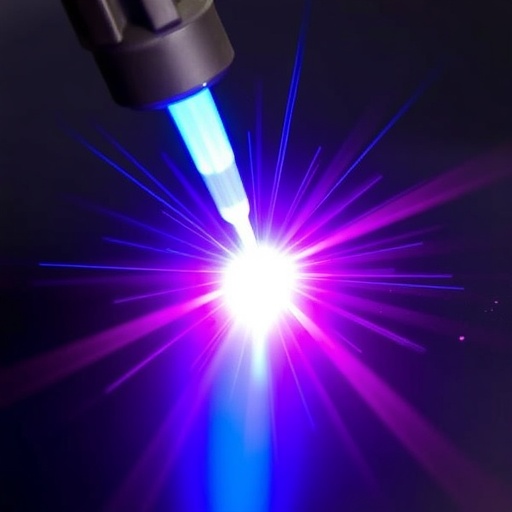A collaborative research initiative at Kanazawa University has made significant advancements in the field of materials science, particularly in the formation of high-performance high-entropy alloy (HEA) films. Led by prominent researchers including Professor Yoji Miyajima and Professor Kazuhiro Ishikawa, this team has pioneered a novel method that eliminates the need for costly alloy targets commonly used in traditional HEA film production. Their innovative approach revolves around utilizing a proprietary rotating target made up of segments of multiple pure metals, combined with pulsed laser deposition (PLD) technology.
This cutting-edge technique of pulsed laser deposition allows for the precise manipulation of metal atoms at the atomic level. By employing intense laser light in a vacuum, the researchers were able to ablate particular metal segments from their rotating target, creating a plasma that then deposits onto a substrate. This method not only allows for the deposition of metal atoms but also enables their implantation into the subsurface of the material. The result is the formation of robust films that exhibit unique characteristics by integrating seamlessly with the substrate, thus enhancing their durability and performance.
One of the most remarkable advantages of this new method is its cost-effectiveness. The traditional approach to producing HEA films requires expensive, pre-made alloy targets. In contrast, the innovative methodology developed by Miyajima and his colleagues leverages inexpensive pure metals. This shift in approach could drastically reduce production costs while maintaining the high-quality attributes associated with HEA films. The potential for widespread application in various industries, from aerospace to medical devices, becomes more feasible with this economic viability.
Further experiments conducted by the research team demonstrated a newfound capability for precise control over film thickness and depth during the deposition process. By regulating the ambient pressure during film formation, the researchers could manipulate these key parameters with remarkable accuracy. This newfound control accelerates the transition from laboratory research to practical applications, potentially benefitting a wide range of sectors that require high-performance materials.
The implications of this research reach far beyond the confines of the laboratory. With the ability to create HEA films that possess enhanced heat resistance, corrosion resistance, and gas barrier properties, various industries are poised to benefit significantly. The aerospace sector, which demands materials that can withstand extreme temperatures and pressures, could see a transformational shift in the materials employed for aircraft components. Additionally, the automotive and energy industries could lower operational costs while increasing the efficiency and longevity of their materials and systems.
The team anticipates applications extending into the realm of medical devices as well. In an era where medical technologies increasingly rely on advanced materials, the incorporation of high-entropy alloys can enhance the durability and effectiveness of surgical instruments, implants, and other critical devices. As the demand grows for materials that extend the life of products and enhance their functionality, the research outcomes could catalyze a significant shift in medical manufacturing.
As detailed in their publication in the prestigious journal Optics & Laser Technology, this research was made possible through a diverse array of funding sources. Support from the Suzuki Foundation, the Amada Foundation, the Japan Society for the Promotion of Science (JSPS), and international collaborations has facilitated the exploration of this innovative technology. The integration of multidisciplinary expertise—from mechanical engineering to materials science—underscores the collaborative nature of modern scientific inquiry.
The research team also highlights the broader implications of their findings within the scientific community. By reducing the reliance on traditional alloy production methods, they are championing a sustainable approach to materials science. As awareness grows regarding environmental concerns and resource limitations, the adoption of such methodologies becomes increasingly relevant. The move toward utilizing pure metals not only caters to cost reduction but also aligns with global sustainability efforts in manufacturing and materials development.
The future of this innovative technique appears promising as researchers continue to explore its limitations and capabilities. Ongoing studies may enhance the understanding of how different elemental compositions can influence the properties of the resulting HEA films. As the scientific community endeavors to refine this process further, the potential for novel applications in yet unexplored fields remains significant.
In conclusion, the groundbreaking research from Kanazawa University represents a pivotal moment in materials science. The advancement in producing high-performance high-entropy alloy films through a cost-effective and versatile method marks a substantial leap towards practical applications across numerous industries. By transcending traditional barriers associated with alloy production, Miyajima and his collaborators are redefining the potential uses of high-entropy alloys and extending the future possibilities for advanced materials. As the research proceeds, the implications for real-world applications in aerospace, automotive, energy, and medical sectors are not just theoretical; they promise to reshape these industries fundamentally.
Subject of Research: Formation of high entropy alloy films using pulsed laser deposition
Article Title: Formation of high entropy alloy films on various substrates via pulsed laser deposition using a rotating multicomponent target
News Publication Date: 17-Jun-2025
Web References: DOI Link
References: Not applicable
Image Credits: © 2025 Miyajima, et al., Optics & Laser Technology
Keywords
High-entropy alloys, pulsed laser deposition, materials science, cost-effective manufacturing, aerospace applications, medical devices, corrosion resistance, heat resistance, gas barrier properties, sustainable materials.




